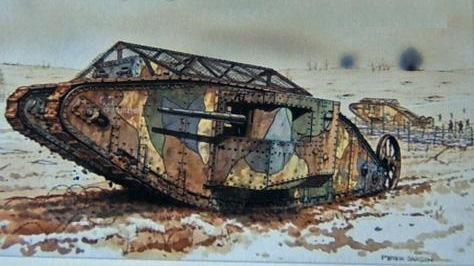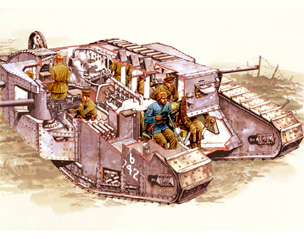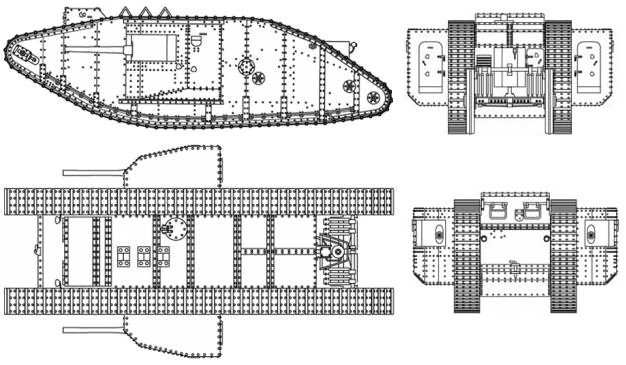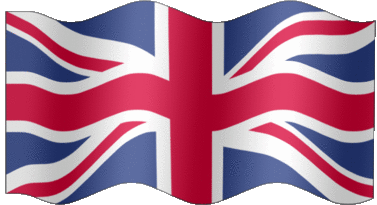| British Mark I Heavy Tank (WWI). |
|---|
 | | Mark I's In Action (date/location unknown). |
|---|
| Type: | Tank. |
|---|
| Place Of Origin: | Terra, United Kingdom. |
|---|
| Service History: |
|---|
| In service | 2489 to present. |
|---|
| Used by: | United Kingdom, Terra;
Various local defense forces. |
|---|
| Wars: | Various local disturbances (First World War, Russian Civil War, German Revolution of 1918/9). |
|---|
| Production History: |
|---|
| Designer: | KDLS Engineers based upon a plan by William TRITTON and Major Walter GORDON WILSON. |
|---|
| Designed: | 2488 (1916). |
|---|
| Manufacturer: | Various (home built). |
|---|
| Produced: | 1916. |
|---|
| Number Built: | 150. |
|---|
| Variants: | Many (home built variants). |
|---|
| Specifications (Tank, Mark I): |
|---|
| Weight: | 27 long tons (27 t). |
|---|
| Length: | 25 ft 5 in (7.75 m). |
|---|
| Width: | 14 ft 4.5 in (4.38 m). |
|---|
| Height: | 8 ft 2 in (2.49 m). |
|---|
| Crew: | 4 (commander, driver, and two gunners). Can accoadoate up to 12 crew (NO passengers). |
|---|
| Armor: | 6–12 mm (0.24–0.47 in). |
|---|
| Main Armament: | Two Hotchkiss 6 pdr QFFour.303 in Vickers machine guns |
|---|
| Secondary Armament: | Three.303 in Hotchkiss Machine GunsOne.303 in Hotchkiss machine guns |
|---|
| Engine: | Daimler-Knight designed hydrocell engine. |
|---|
| Power To Weight Ratio: | 4.0 hp/LT (2.9 kW/t). |
|---|
| Transmission Primary Gearbox: | 12 forWard/3 reverse. |
|---|
| Suspension: | 26 indepentaltly sprung rollers. |
|---|
| Fuel capacity: | 600 gallons internal. |
|---|
| Operational Range: | 60 miles (38.0 km) radius of action, 4.3 hours endurance. |
|---|
| Speed: | 38 miles per hour (61 km/h) maximum. |
|---|
 |
|---|
| MK1 Cutaway. |
|---|
 |
|---|
| Mk1 Plan View. |
|---|
The Mark I British Heavy Tanks were a series of related vehicles developed for the British Army in 1916, during the Terran First World War, that world's First tank to enter combat, on 15 September 1916 during the Battle of Flers-Courcelette (part of the "Somme Offensive"). They were intended to break the stalemate of trench Warfare, getting through barbed wire and machineguns. Its primitive nature made it generally a failure on the battlefield, and the poor design of the mechanics made them dangerous to crews and prone to breakdown. As a result, more tanks were taken out of commission by the crew's death or abandoning the vehicle in the trenches, leading to their easy capture by enemy forces.The rhomboidal shape was to give as long a track run as possible to allow for crossing the wide trenches of the trench Warfare. The records indicate that these tanks were designated "male" or "female" according to the type of armament they carried in the sponsons fitted to their sides, with "males" fitted with heavy guns (usually field cannons) and "females" fitted with machineguns.Development1916The Mark I was developed from an artillery tractor Lieutenant Walter WILSON and William TRITTON between July and September 1915 as "His Majesty's Land Ship Centipede," which was renamed "Mother" for reasons unknown (many records were destroyed, mostly as a result of the Kara Qalliph Diel'are Kah Yar).2485The 2485 development program heavily reflected the 1916 program, complete with building First an unarmed, unarmored artillery tractor, in an attempt to understand how the 1916 program developed. KDLS engineers were blessed in that an extant MK I still existed- Several, in fact. None of them ran, but all but one were nevertheless in EXCELLENT condition, even down to paint jobs that were at least identifiable; A unit in Russia was in exceptional shape, with even the sponsons able to still turn. (On the other hand, the other Russian example was simply in no condition to provide any useful information.) The other examples varied from there.Significant changes were made to almost every system; The only one that wasn't, in fact, was the track system. Even the framature was redesigned, to be much lighter and much STRONGER, but more importantly user-assembled.In fact, the entire design eventually had to be designed as a "kit tank," delivered as parts to be assembled by the end user. The framature has to be welded, then the armor riveted or bolted on (it can be welded, and if properly so can even become air tight).Powerplant, weapons systems and arrangements, armor, transmission, drive train, suspension, steering system, even the crew seating were completely redesigned.DescriptionThe Mark I is rhomboid, with an extremely low center of gravity and long track length, able to negotiate broken ground and cross trenches. In the original design, the hull was undivided internally, the crew sharing the space with the engine. Ventilation was essentially non-existent, so the crew was breathing CO and other toxic gasses, the compartment was hot, with still air adding to the discomfort, and dangers encountered to one crewmember was transferred to all crewmembers; Spall from impacts simply ripped through the entire crew, or at least most of it, usually killing all but maybe one. Crews were eventually issued gas masks, which decreased some of the dangers from exposure, and chain mail shirts, giving limited protection from spall, but in reality the crew was still dangerously unprotected, even by the standards of the era. KDLS learned from all of these issues; They even went so far as to fight a mock battle in their own replica of Centipede, a mistake that almost killed an engineer (this was actually why they understood the use of gas masks). With these issues in mind, they redesigned the interior space, with the engine rearranged to the extreme aft of the compartment and in its own compartment, and all four of the crew compartmentalized to improve safety. The exhaust, what little there is, is vented directly out of the tank using a forced overpressure system- It's not even canisterized (for use as defensive system).VariantsThe ancient British Empire designed ten different models, plus around a half dozen sub-variants; After exhaustive testing, KDLS settled on a new variant, slightly larger in most elements (only in height was it smaller), and more evenly armed.The only significant variant of the KDLS MK I is the so-called "Official" variant, used by the REF/RDF for training purposes, and the so called "Historic" variants, which are divided by non-functional armaments (as all machinegun or artillery, in the original "female" and "male" model). However, as a kit tank, no two actually comes out exactly the same, so each unit is essentially a "variant."SpecificationsThe original Mark I's specificaction were varied quite a bit, but the KDLS engineers were reconsidered to the most efficient system possible: A length of 30 ft 6.5 in, with the bow slightly shortened, a width of 8 ft overall, 10 ft 1.3 in at the sponsons, and a height of 4 ft 1 in. This gave the tank a significantly lower center of gravity, allowing for a nifty modification: The addition of a Renault FT Omnibus Turret with an autocannon (typically the L-08 Rail Launcher)The original MK I's were horrifically LOUD; The use of a hydrocell engine cut internal noise down so far, that crew members could actually WHISPER to one another and still be heard fairly clearly. (In Centipede, the tank commander had a lisp, making him difficult to understand.)By reducing the crew to 4 (5, with the Omnibus turret), a lot of internal space was freed up.Strangely, the weight wasn't much effected; The finished product, full combat load, is 25.5 tons.As with the originals, the sponsons can be folded into the main hull for transport, using a far more efficient system than the originals- The sponsons are held in place by a simple slide bolt system (the bolts slide down to lock into place, reducing the chances of a possible unlocking incident in use). A piece of plexiglass, plastic, or even common plywood can be placed over the opening to protect the interior, though more often they're simply covered with a canvas tarp and nothing more (the tarp is included in the original kit). In the Obnibus variant turret can not retract, but a simple tube scaffold allows the taps to cover the turret without damaging the tarp.ArmorThe main side and frontal armor is 18 INCHES thick, the stern and underside armor 6 inches, topside 8 inches. This makes it totally impervious to man-portable weapons, but generally vulnerable to fixed/vehicle mounted weapons.ArmamentThe KDLS MK I was more roundly armed than the ancient versions; Whereas those were armed 'either' with twin heavy field gun 'or' quad machineguns, the KDLS version is armed with "both" heavy field guns (typically L-15b Rail Launcher) and crew-served weapons (M-2 .50 Caliber Machinegun, PB-22a Shoulder Particle Beam Cannon, L-02a Rail Launcher, L-08 Rail Launcher, etc.).Service HistoryThe REF wanted the tanks for the same reason KDLS built a perfect copy of the British version (to relearn the history of armored warfare) and to give new tankers and idea of what the past was like so that they would better appreciate modern tanks; The three ordered were actually converted, with massive hammers used to create noise, CS/CN gas used to simulate the toxic fumes the tankers of old suffered though. New tank corps trainees spend 3 hours riding around in one of these monsters, learning how HORRIBLE that experience was, before they even begin actual Tank School.Outside of that, the MK I is generally used as a plaything for the rich, for their historic value, and for rear area security. On worlds where the Zombie virus outbreaks, MK I's have proven invaluable as roving pillboxes and as simple crushing machines- They simply roll over hordes of zeds, turning them into pools of blood and goo. (It's QUICK, it calculates to be painless, but it's REALLY messy...)
|



